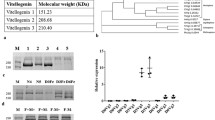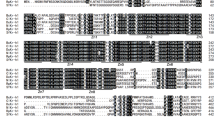Abstract
Most animals use proteins, peptides, steroids, eicosanoids, or amino acid derivatives as chemical signals, along with receptors, secondary messengers, transduction systems, and transcription factors to finely control reproduction. Many protostomes have complex endocrine systems with vertebrate-like sex steroid receptors, but some are unresponsive to vertebrate sex steroids. Others are responsive to estrogen and testosterone, but the effects are mediated through non-estrogen receptor pathways. In this article, I review the pheromones that rotifers use to synchronize reproduction and rotifer response to waterborne vertebrate steroid hormones. I also describe the impact on rotifer reproduction of endocrine disruptors that mimic androgens and their antagonists. A fraction of the brachionid transcriptome is surveyed for candidates involved in endocrine signaling systems and genes are identified that are putatively involved in steroidogenesis and oocyte maturation. We use the new technique of RNAi in rotifers to selectively knock down gene expression and identify the functional roles of genes involved in the regulation of reproduction.



Similar content being viewed by others
References
Bertrand, S., F. G. Brunet, H. Escriva, G. Parmentier, V. Laudet & M. Robinson-Rechavi, 2004. Evolutionary genomics of nuclear receptors: from twenty-five ancestral genes to derived endocrine systems. Molecular Biology and Evolution 21: 1923–1937.
Brown, K. A., K. Sayasith, N. Bouchard, J. G. Lussier & J. Sirois, 2007. Molecular cloning of equine 17β-hydroxysteroid dehydrogenase type 1 and its down regulation during follicular luteinization in vivo. Journal of Molecular Endocrinology 38: 67–78.
Cerutti, H. & J. A. Casas-Mollano, 2006. On the origin and functions of RNA-mediated silencing: from protists to man. Current Genetics 50: 81–99.
DeFur, P. L., M. Crane, C. Ingersoll & L. Tattersfield, 1999. Endocrine Disruption in Invertebrates: Endocrinology, Testing and Assessment. SETAC Press, Pensacola, FL.
Denekamp, N. Y., M. A. S. Thorne, M. S. Clark, M. Kube, R. Reinhardt & E. Lubzens, 2009. Discovering genes associated with dormancy in the monogonont rotifer Brachionus plicatilis. BMC Genomics 10: 108–125.
East, L. & C. M. Isacke, 2002. The mannose receptor family. Biochimica et Biophysica Acta 1572: 364–386.
Escriva, H., F. Delaunay & V. Laudet, 2000. Ligand binding and nuclear receptor evolution. Bioessays 22: 717–727.
Fire, A., S. Xu, M. K. Montgomery, S. A. Kostas, S. E. Driver & C. C. Mello, 1998. Potent and specific genetic interference by double-stranded RNA in Caenorhabditis elegans. Nature 391: 806–811.
Gallardo, W., Y. Tomita, A. Hagiwara, K. Soyano & T. W. Snell, 1997. Effect of some vertebrate and invertebrate hormones on the population growth, mictic female production, and body size of the marine rotifer Brachionus plicatilis Muller. Hydrobiologia 358: 113–120.
Gallardo, W. G., A. Hagiwara, Y. Tomita & T. W. Snell, 1999. Effect of growth hormone and gamma-aminobutyric acid on Brachionus plicatilis (Rotifera) reproduction at low food or high ammonia levels. Journal Experimental Marine Biology & Ecology 240: 179–191.
Gallardo, W. G., A. Hagiwara & T. W. Snell, 2000. Effect of juvenile hormone and serotonin (5-HT) on mixis induction of the rotifer Brachionus plicatilis Muller. Journal Experimental Marine Biology & Ecology 252: 97–107.
Garcia-Alonso, J. & N. Rebscher, 2005. Estradiol signalling in Nereis virens reproduction. Invertebrate Reproduction & Development 48: 95–100.
Garcia-Alonso, J., U. Hoeger & N. Rebscher, 2006. Regulation of vitellogenesis in Nereis virens (Annelida: Polychaeta): effect of estradiol-17β on eleocytes. Comparative Biochemistry & Physiology Part A: Molecular & Integrative Physiology 143: 55–61.
Gilbert, J. J., 1963. Contact chemoreception, mating behaviour, and sexual isolation in the rotifer genus Brachionus. Journal Experimental Biology 40: 625–641.
Gilbert, J. J., 1983. Rotifera. In Adiyodi, K. G. & R. G. Adiyodi (eds), Reproductive Biology of Invertebrates. Oogenesis, Oviposition, and Oosorption, Vol. 1. John Wiley & Sons, Ltd, New York: 181–209.
Gilbert, J. J., 2002. Endogenous regulation of environmentally-induced sexuality in a rotifer: a multi-generational parental effect induced by fertilization. Freshwater Biology 47: 1633–1641.
Graham, J. D. & C. L. Clarke, 1997. Physiological action of progesterone in target tissues. Endocrinology Reviews 18: 502–519.
Guillette Jr., L. J., D. B. Pickford, D. A. Crain, A. A. Rooney & H. F. Percival, 1996. Reduction in penis size and plasma testosterone concentrations in juvenile alligators living in a contaminated environment. General and Comparative Endocrinology 101: 32–42.
Heyland, A., J. Hodin & A. M. Reitzel, 2004. Hormone signaling in evolution and development: a non-model system approach. BioEssays 27: 64–75.
Keay, J. & J. W. Thornton, 2009. Hormone-activated estrogen receptors in annelid invertebrates: implications for evolution and endocrine disruption. Endocrinology 150: 1731–1738.
Kohler, H.-R., W. Kloas, M. Schirling, I. Lutz, A. L. Reye, J. S. Langen, R. Triebskorn, R. Nagel & G. Schonfelder, 2007. Sex steroid receptor evolution and signalling in aquatic invertebrates. Ecotoxicology 16: 131–143.
Krieger, J. & H. Breer, 1999. Olfactory reception in invertebrates. Science 286: 720–723.
Kubanek, J. & T. W. Snell, 2008. Quorum sensing in rotifers. In Winans, S. C. & B. L. Bassler (eds), Chemical Communication Among Microbes. ASM Press, Washington, DC: 453–461.
Lafont, R. & M. Mathieu, 2007. Steroids in aquatic invertebrates. Ecotoxicology 16: 109–130.
Mathiessen, P. & P. E. Gibbs, 1998. Critical appraisal of the evidence for tributyltin mediated endocrine disruption in molluscs. Environmental Toxicology and Chemistry 17: 37–43.
Miller, M. B. & B. L. Bassler, 2003. Quorum sensing in bacteria. Annual Review Microbiology 55: 165–199.
Mizutani, Y., A. Kihara & Y. Igarashi, 2004. Identification of the human sphingolipid C4-hydroxylase, hDES2, and its up-regulation during keratinocyte differentiation. FEBS Letters 563: 93–97.
Novillo, A., S. J. Won, C. Li & I. P. Callard, 2005. Changes in nuclear receptor and vitellogenin gene expression in response to steroids and heavy metal in Caenorhabditis elegans. Integrative & Comparative Biology 45: 61–71.
Preston, B. L., T. W. Snell, T. L. Robinson & B. J. Dingmann, 2000. Use of the freshwater rotifer Brachionus calyciflorus in a screening assay for potential endocrine disruptors. Environmental Toxicology Chemistry 19: 2923–2928.
Radix, P., G. Severin, K. W. Schramm & A. Kettrup, 2002. Reproduction disturbances of Brachionus calyciflorus (rotifer) for the screening of environmental endocrine disrupters. Chemosphere 47: 1097–1101.
Schmitt, A. & A. R. Nebreda, 2002. Signalling pathways in oocyte meiotic maturation. Journal of Cell Science 115: 2457–2459.
Serra, M., T. W. Snell & J. J. Gilbert, 2005. Delayed mixis in rotifers: an adaptive response to the effects of density-dependent sex on population growth. Journal of Plankton Research 27: 37–45.
Shabalina, S. A. & E. V. Koonin, 2008. Origins and evolution of eukaryotic RNA interference. Trends in Ecology & Evolution 23: 578–587.
Snell, T. W. & N. J. D. DesRosiers, 2008. Effect of progesterone on sexual reproduction of Brachionus manjavacas (Rotifera). Journal Experimental Marine Biology & Ecology 363: 104–109.
Snell, T. W. & C. Joaquim-Justo, 2007. Workshop on rotifers in ecotoxicology. Hydrobiologia 593: 227–232.
Snell, T. W. & M. A. Nacionales, 1990. Sex pheromones and mate recognition in rotifers. Comparative Biochemistry and Physiology 97A: 211–216.
Snell, T. W. & C. P. Stelzer, 2005. Removal of surface glycoproteins and transfer among Brachionus species. Hydrobiologia 546: 267–274.
Snell, T. W., R. Rico-Martinez, L. N. Kelly & T. E. Battle, 1995. Identification of a sex pheromone from a rotifer. Marine Biology 123: 347–353.
Snell, T. W., J. M. Kubanek, W. E. Carter, A. B. Payne, J. Kim, M. Hicks & C. P. Stelzer, 2006. A protein signal triggers sexual reproduction in Brachionus plicatilis (Rotifera). Marine Biology 149: 763–773.
Snell, T. W., T. L. Shearer, H. A. Smith, J. Kubanek, K. E. Gribble, & D. B. Mark Welch, 2009. Genetic determinants of mate recognition in Brachionus manjavacas (Rotifera). BMC Biology 7: 60.
Snell, T. W., T. L. Shearer & H. A. Smith, 2010. Exposure to dsRNA produces RNA interference in Brachionus manjavacas (Rotifera). Marine Biotechnology. doi:10.1007/s10126-010-9295-x.
Stelzer, C. P. & T. W. Snell, 2006. Specificity of the crowding response in the Brachionus plicatilis species complex (Rotifera). Limnology and Oceanography 51: 125–130.
Stoka, A. M., 1999. Phylogeny and evolution of chemical communication: an endocrine approach. Journal of Molecular Endocrinology 22: 207–225.
Stout, E. P., J. J. La Clair, T. W. Snell, T. L. Shearer & J. Kubanek, 2010. Conservation of progesterone hormone function in invertebrate reproduction. Proceedings of the National Academy of Sciences, USA 107: 11859–11864.
Suga, K., D. Mark Welch, Y. Tanaka, Y. Sakakura & A. Hagiwara, 2007. Analysis of expressed sequence tags of the cyclically parthenogenetic rotifer Brachionus plicatilis. PLoS ONE 2: e671.
Thornton, J. W., E. Need & D. Crews, 2003. Resurrecting the ancestral steroid receptor: ancient origin of estrogen signaling. Science 301: 1714–1717.
Tsai, M.-J. & B.-W. O’Malley, 1994. Molecular mechanisms of action of steroid/thyroid receptor superfamily members. Annual Review Biochemistry 63: 451–486.
Whangbo, J. S. & C. P. Hunter, 2008. Environmental RNA interference. Trends in Genetics 24: 297–305.
Wyatt, T. D., 2003. Pheromones and Animal Behavior. Cambridge University Press, Cambridge, UK.
Acknowledgments
This work was supported by the National Science Foundation grant BE/GenEn MCB-0412674. Hilary A. Smith made useful comments that improved this article. Many people contributed to this work including David Mark Welch, Julia Kubanek, Manuel Serra, Atsushi Hagiwara, Tonya L. Shearer, Kristen Gribble, Hilary A. Smith, Daniel Hicks, Eric Tvedte, Sohee Park, and Monica Huynh.
Author information
Authors and Affiliations
Corresponding author
Additional information
Guest editors: N. Walz, R. Adrian, J.J. Gilbert, M.T. Monaghan, G. Weithoff & H. Zimmermann-Timm / Rotifera XII: New aspects in rotifer evolution, genetics, reproduction, ecology and biogeography
Rights and permissions
About this article
Cite this article
Snell, T.W. A review of the molecular mechanisms of monogonont rotifer reproduction. Hydrobiologia 662, 89–97 (2011). https://doi.org/10.1007/s10750-010-0483-5
Published:
Issue Date:
DOI: https://doi.org/10.1007/s10750-010-0483-5




